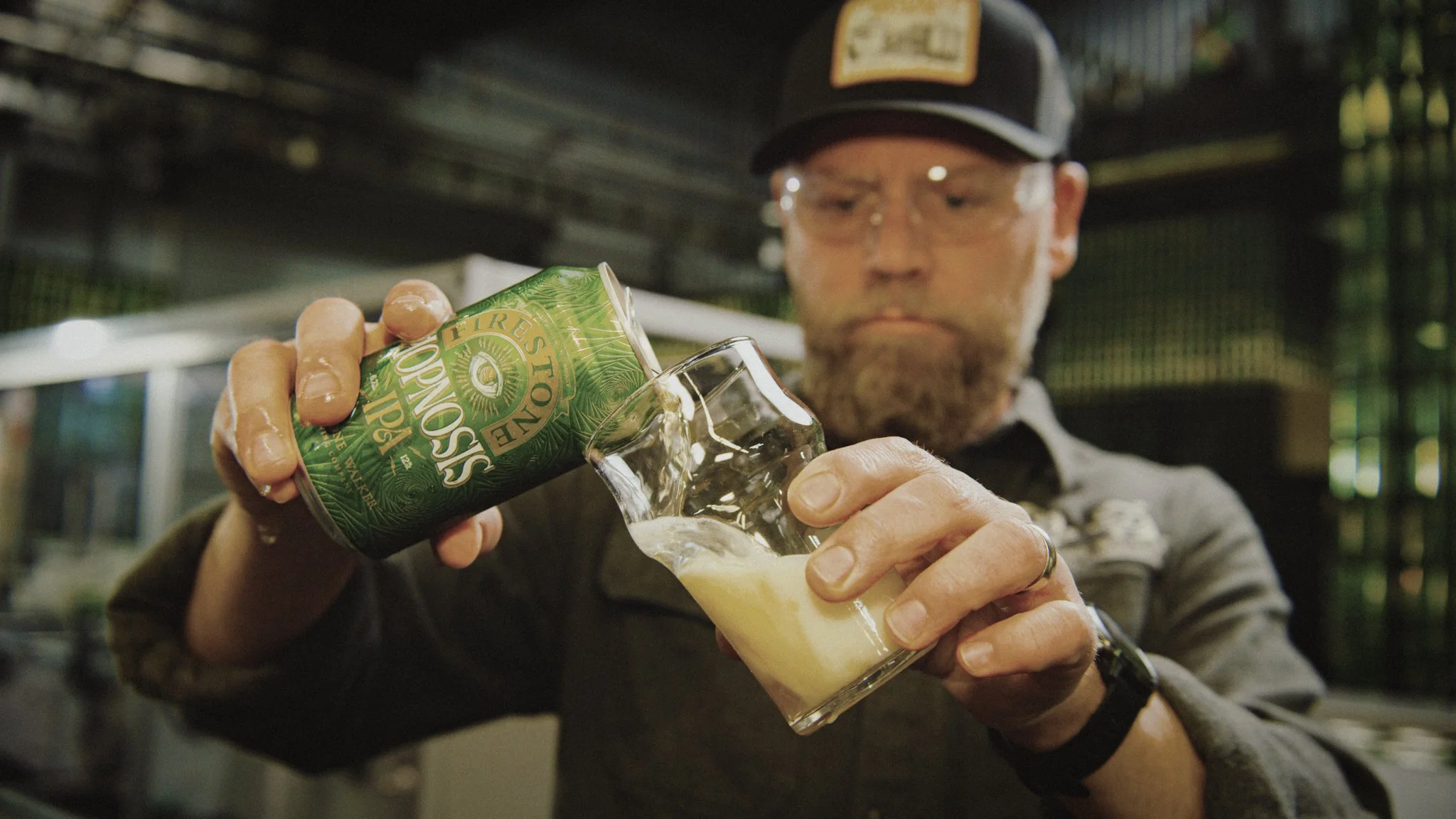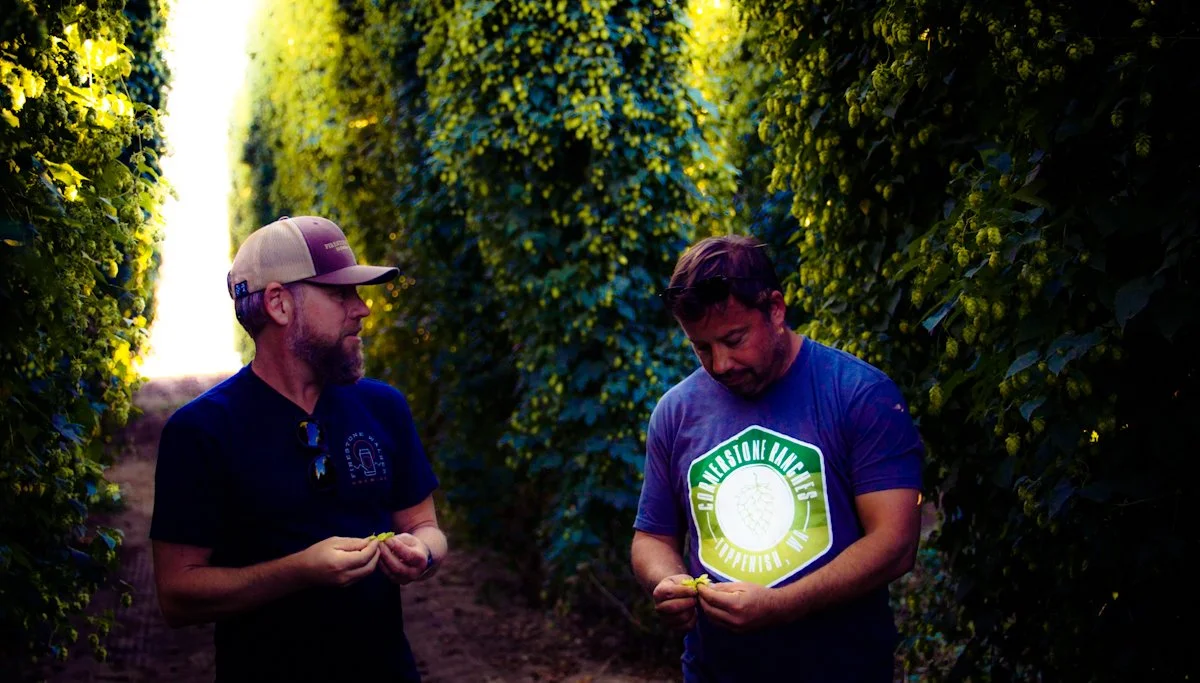A Farmer & Brewer’s Hop Dreams
Hops are the stuff that dreams are made of, atleast for craft brewers like Firestone Walker Brewing’s Matt Brynildson and farmers like Graham Gamache who have devoted much of their lives to the flowering seed cones that are the essence of modern beer flavors. In a new short film titled Hop Dreams we travel to Washington’s Yakima Valley, and explore brewers relationship with the farmers, digging deeper, this companion piece examines the importance of that partnership and the mutual benefits of a greater understanding between business and craft.
“The more time you are in the beer business, the more time you end up spending on farms. The more time you spend with farmers the better beer you are going to make.”
The film follows Brynildson, along with Propagator Brewing Manager Sam Tierney and Raw Materials Manager Tim Miller as they make their annual pilgrimage to Yakima Valley to source the next great hops. Graham Gamache is a central figure in the valley and in the film, as well as an important player in how craft beer tastes today.
“I have memories of being out in the field and orchards as early as 10 years old,” says Graham Gamache of Cornerstone Ranches in Toppenish, Washington. “I was born into it. I am the fifth generation in my line to farm hops and the third generation on this particular piece of dirt.”
Graham Gamache of Cornerstone Ranches
In 2013 Graham purchased the Amos Gamace Farms from his father and uncle and placed them under a parent operating company called Cornerstone Ranches. Before he literally bought the farm, Graham was a fan of craft beer, and an admirer of Firestone Walker Brewing. When he launched Cornerstone Ranches he made up his mind to cold call co-founder Adam Firestone to say he wanted to establish a direct relationship from farm to brewer.
“He was very gracious [Adam Firestone] and invited to give me a tour of his facility and a meeting,” recalls Graham. “I flew myself to Paso Robles and he picked me up at the local airport and he made good on his word. It was Great!! I met Matt [Brynildson] then in his office and we talked hops and turned out we knew a lot of the same people.”
In the following years that relationship has grown stronger with Cornerstone Ranches development of new varietals like Cashmere, which has become a favorite hop of Brynildson, and a central focus in Firestone Walker’s new Hopnosis IPA and Mind Haze.
Matt Brynildson pours his new Hopnosis IPA built around Yakima valley grown Cashmere hops and Cryo Mosaic
Brynildson says that Graham and Cornerstone Ranches is a prime example of a grower really getting in the groove with a certain variety, “Their family figured it out and continued to pass on that knowledge for sure, I don’t want to speak for him but it seems like he kind of works to the beat of his own drum. He’s not quick to jump on trends, but with Cashmere, it was so obvious that he really has a bead on it.”
As the industry has shifted more towards privately held hop cultivars, the world of hop-forward innovation has become more exciting. In Brynildson’s eyes that has been a “game changer, and largely positive” but comes with it’s own unique hurdles. “Some brewers are looking for the best hop at any given time, but we are looking first for consistency,” he says. This is why Brynildson and others travel to the Yakima Valley every hop harvest to experience the year’s crop first-hand. This is where growers and merchants are showing off new cultivars, and brewers can get the first whiff at potential new game changers as well as following the changes in varieties from year-to-year, and farm-to-farm.
“The most important thing is true to type, and it might mean something different to each brewer, but ultimately you are looking for some common thread year to year, some consistency that you can find so that your beer stays true to type as you possibly can,” says Brynildson about what he looks for in the hop harvest each year.
A successful hop farmer does not make a career on simply following the latest experimental hop varieties or fad flavors that may not have a lasting impact. A farmer has to think long-term because hop fields don’t grow in days or months, but take years to bring to yield and has to prove it is agronomically profitable for the grower before it gets in front of brewers. For every Mosaic or Cashmere, there are dozens of hyped up varieties that disappear like a flash in the brew kettle.
With one finger on the pulse of the industry and another on the terroir, Brynildson has mixed feelings, “It’s probably the old man in me, but sometimes I think we need to slow down on all the new cultivars. Instead of constantly tearing out one hop to put into another, it mirrors the brewing industry where some brands are so quick to jump on a trend that might be gone in a flash.”
Farmer are paid on lbs. not hype. Having a good yield from year to year is of the utmost importance, this is why hops like Centennial are such standards for their reliability. Getting a good yield is determined by picking at just the right time, and every hop has it’s own schedule in direct relation with it’s quality.
“A hop cone is at its highest weight and peak quality when it is peak ripe,” says Graham when asked about the most important aspect of his job. “So we use various methods to determine when peak ripe is and try to pick all varieties in the optimum window. Picking windows are of prime importance.”
Matt Brynildson receives Knighthood in the International Order of the Hop
As a master brewer you want to concern yourself with all aspects of production, and that means understanding the picking window like a farmer does. That sort of knowledge and attention to detail is what helped Matt Brynildson become one of the very few brewers in the world to receive the prestigious “International Order of the Hop” recognition in Prague earlier this year.
“Matt has a good nose and knows exactly what to look for when selecting hops for his brews,” says Graham. “I appreciate not only his dedication to quality and the specific aroma profiles he is looking for but also his knowledge of the hop industry, our industry and his loyalty to good partners.”
But hop growing is not all luscious green hop flowers, and both grower and brewers hop dreams can become nightmares.
“You flat out, cant ignore climate change,” says Brynildson. “When I went to the hop growers conference that just came up over and over, you cant ignore high temps and low precipitation. When they have these hot and dry temperature years they really suffer. “
Graham’s primary concern for the future is the infrastructure required for processing hops has grown so much in the last decade to meet the increasing demand for craft beer. This leaves farmers tied to brewers fulfilling their hop contracts while the growers are putting down huge costly investments.
“The challenge now will be in maintaining a balance of supply, so the market is not overwhelmed with unnecessary hops. It will also be a challenge to balance good research and development of new hop varieties with the demand of what the brewers are actually looking for,” says Graham.
The short film “Hop Dreams” reveals how important these relationships with some of the world’s top hop growers are from soil to sunlight, conception to reality, raw material to the liquid in your glass. The brewer and the farmers fates are ultimately tied together and will be rewarded with good fortune by a greater appreciation of each other's industries.
“I go onto a farm and my mind gets blown. Growing hops is more complicated than brewing beer!” says Brynildson with a chuckle.
While Graham is heartened by mutual understanding and deepening relationships.
“It takes quite a long time to develop a new variety and scale it to commercial production. I think it will be the responsibility of excellent brewers like Matt and others in the hop industry to shepherd this growth in the correct direction.”
Matt Brynildson (left) with Graham Gamache (right) at Cornerstone Ranches in Toppenish, Washington







